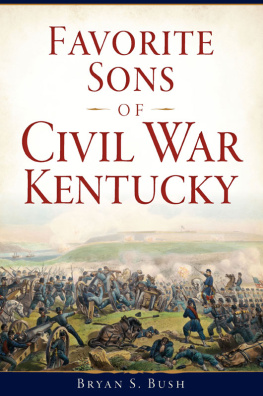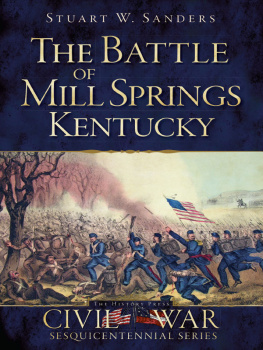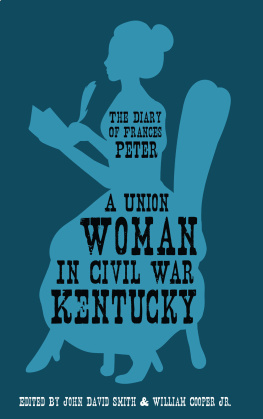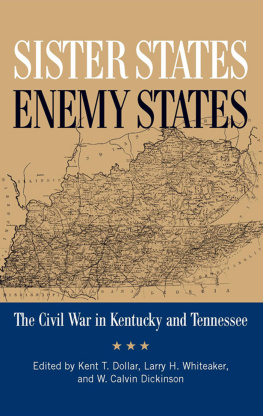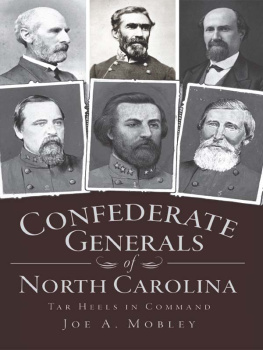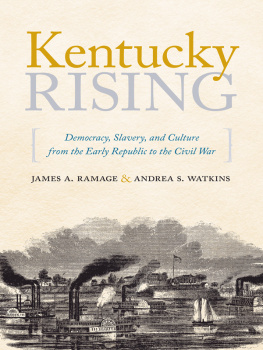2010 The University of North Carolina Press
All rights reserved. Designed by Courtney Leigh Baker and Set in Arnhem with American Scribe Display by Achorn International, Inc. Manufactured in the United States of America. The paper in this book meets the guidelines for permanence and durability of the Committee on Production Guidelines for Book Longevity of the Council on Library Resources. The University of North Carolina Press has been a member of the Green Press Initiative since 2003.
Library of Congress Cataloging-in-Publication Data
Marshall, Anne E. (Anne Elizabeth), 1975
Creating a Confederate Kentucky : the lost cause and Civil War
memory in a border state / Anne E. Marshall.1st ed.
p.cm. (Civil War America)
Includes bibliographical references and index.
ISBN 978-0-8078-3436-7 (cloth : alk. paper)
1.KentuckyHistoryCivil War, 18611865Social aspects.
2.Collective memoryKentucky.
3.MemorySocial aspects Kentucky.
4.KentuckyHistoryCivil War, 18611865Influence.
5.United StatesHistoryCivil War, 18611865Social aspects.
6.United StatesHistoryCivil War, 18611865Influence. I.Title.
E509.M 37 2010
976.9'03dc22 2010020419
cloth 14 13 12 11 10 5 4 3 2 1
Contents
1A MARKED CHANGE IN THE SENTIMENTS OF THE PEOPLE
Slavery, Civil War, and Emancipation in Kentucky, 1792-1865
2THE REBEL SPIRIT IN KENTUCKY
The Politics of Readjustment, 1865-1877
3WICKED AND LAWLESS MEN
Violence and Confederate Identity, 1865-1885
4WHAT SHALL BE THE MORAL TO YOUR KENTUCKIANS?
Civil War Memorial Activity in the Commonwealth, 1865-1895
5TWO KENTUCKYS
Civil War Identity in Appalachian Kentucky, 1865-1915
6A PLACE FULL OF COLORED PEOPLE, PRETTY GIRLS, AND POLITE MEN
Literature, Confederate Identity, and Kentuckys Reputation, 1890-1915
7A MANIFEST AVERSION TO THE UNION CAUSE
War Memory in Kentucky, 1895-1935
Illustrations
Scene from Confedrit X Roads
Henry Watterson, as portrayed in Harpers Weekly
State seal of Kentucky as revised after Goebel assassination, 1900
Annie Fellows Johnston and Hattie Cochran
Photograph of Rebecca Porter, model for Annie Fellows Johnstons Mom Beck
Paul Laurence Dunbars Nelse Hatton, in Folks from Dixie
John Hunt Morgan monument unveiling, Lexington, 1911
Abraham Lincolns birthplace cabin, Louisville, 1906
Monument to African American refugees, Camp Nelson, Kentucky
Acknowledgments
Though the experience of writing a history book is meant to be a solitary one, mine has been anything but. Since I began to conceive of this project over ten years ago, I feel as though I have been in constant conversation with mentors, professors, colleagues, academic observers, history buffs, thinkers, and well-wishers. I offer many thanks to Centre College professors Milton Reigelman, Mark Lucas, Elizabeth Perkins, Clarence Wyatt, and Michael Hamm, whose passionate sense of inquiry and wonderful teaching made me want to pursue this line of work in the first place.
I am greatly beholden to the archivists who aided me in unearthing all of the scattered clues and slippery ways that helped me define the strange ways in which Kentuckians remembered the Civil War: the staff at repositories around the state, including the staff at the Kentucky Heritage Council State Historic Preservation Office; Gordon Hogg and Frank Stanger at University of Kentucky Special Collections; Betsy Morelock at Kentucky State University; and Shannon Wilson at Berea College. I would especially like to thank the good folks at the Filson Historical Society: Mark Wetherington, Jim Holmberg, and Shirley Harmon, who made my Filson Fellowship experience so productive and rewarding. I also want to thank all those who were at the Kentucky Historical Society at the time I conducted research there: Lynne Hollingsworth, Ken Williams, Beth Van Allen, Stuart Sanders, Nelson Dawson, Marilyn Zoidis, Diane Bundy, Darrel Meadows, and Tony Curtis all generously shared their ideas and insights and offered many kinds of support.
I have also been lucky to have wonderful role models in the historians of Kentucky who have preceded me. The late Thomas D. Clark, William Freehling, and James Klotter have been generous with their inspiration and encouragement. I am fortunate to be working at a time in which there is burgeoning scholarship on postCivil War Kentucky. Thanks to Helen Lacroix, Aaron Astor, and Luke Harlow for their camaraderie and wonderful insights.
Much of this project germinated during the time I was a graduate student at the University of Georgia, where I had great friends, colleagues, and mentors. Tammy Ingram, Bruce Stewart, Alex Macaulay, Jennifer Gross, Judkin Browning, Robby Luckett, Laura Mason, Steven Soper, Susan Rosenbaum, and Kathleen Clark all helped to shape this project with their support and ideas. John Inscoe was particularly generous with his time and support, and I am grateful for his infectious enthusiasm and advice as the work was beginning to take shape.
It goes without saying that anyone interested in probing questions of southern regional identity and historical memory could not have a better example to follow than James C. Cobb. I have always appreciated his willingness to mentor me and his insistence that questions like the ones I was asking were as much about spending time chewing on the end of my pencil as they were about time spent in archives. Last but not least, I thank him for providing living proof that great intellectual measure does not have to be accompanied by pretension.
My life has also been made profoundly better by my friendship with Bryant Simon and his family. I will be forever grateful for the time he spent teaching me to be a better scholar and writer, and even more thankful for the way that he, Ann Marie, Benjamin, and Eli have included me in their lives over the years.
In the past few years at Mississippi State University, I have been privileged to have wonderfully engaged colleagues like Jason Phillips, Kathryn Barbier, and Alan Marcus, who have provided me with the encouragement and impetus to complete this project.
I am so very fortunate to have had a loving and supporting family throughout this long endeavor. My parents-in-law, Barb Giesen and Phil Giesen, have offered continual interest and encouragement. My sister, Jennifer, an accountant, has offered moral support and assurance that one day I too might become financially solvent. Most of all, my parents, Jan and Bill Marshall, have supported me in more ways than I can count. As historians, librarians, research assistants, proofreaders, and providers of financial assistance, they have selflessly given me more assistance than anyone could ever deserve. Through countless educational vacation excursions, which I resisted in my youth, they planted an appreciation of and respect for history upon which I continually draw. For this, and because I will be eternally grateful for all they have done for me, I dedicate this book to them.


